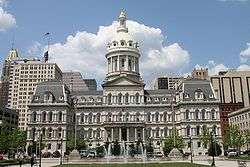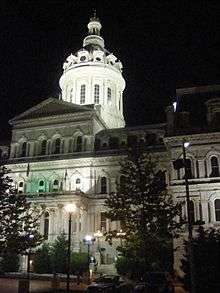George A. Frederick
| George A. Frederick | |
|---|---|
| Born |
December 16, 1842 Maryland |
| Died |
August 17, 1924 (aged 81) Baltimore, Maryland |
| Nationality | American |
| Occupation | Architect |
| Buildings | Baltimore City Hall (1867-1875); The Baltimore City College (high school), (1873-1875), [first of two on site]; Maryland House of Correction (Jessup) (1878); Abell Building (Baltimore), southeast corner, East Baltimore and South Eutaw Streets; Howard Peters Rawlings Conservatory and Botanic Gardens of Baltimore (formerly Baltimore City Conservatory and Botanical Gardens), (1888), in Druid Hill Park; |
| Projects |
Repairs to the Maryland State House (Annapolis); Architect to the Baltimore City Board of Parks Commissioners, 1863-1895 for various city parks structures; Maryland Exposition Building, built 1893 for World's Columbian Exposition (Chicago World's Fair - 1878 awards = Fellowship with the American Institute of Architects, 1877 |
George Aloysius Frederick (December 16, 1842 – August 17, 1924) was a German-American architect with a practice in Baltimore, Maryland, where his most prominent commission was the Baltimore City Hall (1867–1875), awarded him when he was only age 21. Later in the late 19th century, he served as the semi-official municipal architect.

, 100 Holiday Street, City Hall/War Memorial Plaza,
.jpg)
He had apprenticed with a Baltimore architectural partnership with Lind & Murdoch,[1] architects of the Peabody Institute (1857-1860) at North Charles Street (Washington Place) and East Mount Vernon Place (East Monument Street). He designed structures for Baltimore's extensive Druid Hill Park, then beyond the 1818 northwest city limits, purchased for the city in 1860, and designed by Howard Daniels, Baltimore City Park Commissioners' landscape designer and John H.B. Latrobe,[2] who designed the gateways to the park and the alterations made to the early-19th century Col. Nicholas Rogers mansion "Druid Hill" that already stood on the site. Druid Hill Park ranks with Central Park in New York, begun in 1859, and Fairmount Park in [[Philadelphia as the oldest landscaped public parks in the United States. Among Frederick's playful structures for Druid Hill in Moorish and Chinese styles is the Chinese Station erected in 1864[3] and the Moorish Station,[4] which were stops on a narrow-gauge railroad that once wound through the park.

The commission for the Baltimore City Hall was awarded after a design competition to Frederick, a complete unknown and not quite twenty, in the fateful year 1860. The Civil War intervened, and construction finally got under way in 1867. Frederick's design looked to the new additions to the Palais du Louvre, completed under Hector Lefuel in 1857, and well publicized to professionals and architects alike through engravings, lithographs and description; its high Mansard roofs, bold corner pavilions, richly framed dormers are reflected in Frederick's City Hall,[5] above which rises the central dome, 227 feet (69 m) high, above an interior rotunda 119 feet (36 m) high. Twin interior courts provided every room with natural light.
Well launched by the City Hall, which influenced the design of every ambitious commercial building in Baltimore for more than a decade, Frederick went on to design the premises of the major German-American newspaper The German Correspondent, completed in 1869 on a prominent corner lot on Baltimore Avenue; it had three main floors and an attic behind French mansards, with a marble-clad facing with Venetian-Gothic windows. The German Orphan Asylum (1873) was another German-American commission.
In 1868 Frederick was a founder of the Baltimore chapter of the American Institute of Architects.
References
- Chalkley, Tom. "Built to Last." Charmed Life. City Paper, Baltimore, 10 November 1999.
- Dorsey, John and James D. Dilts. A Guide to Baltimore Architects. 3rd Edition. Centreville, MD: Tidewater Publishers, 1997.
- Frederick, George A. "Recollections of George A. Frederick." 1912. Maryland Historical Society
- "Frederick, George Aloysius." The National Cyclopaedia of American Biography being the History of the United States. Vol. IX. New York: James T. White & Company, 1899. p. 334.
- "George A. Frederick." Baltimore Architecture Foundation. 18 Oct. 2007
- George A. Frederick. Biography. Maryland State Archives.
- "George Aloysius Frederick." Baltimore Architects. The Sun, Baltimore, 22 September 1954.
- Giza, Joanne and Catharine F. Black. "Cylburn." Great Baltimore Houses: An Architectural and Social History. Baltimore: Maclay & Associates, 1982. p. 79-81.
- Hayward, Mary Ellen and Frank R. Shivers, Jr. The Architecture of Baltimore: An Illustrated History. Baltimore: The Johns Hopkins University Press, 2004.
- Jones, Carleton. Lost Baltimore Landmarks: A Portfolio of Vanished Buildings. Baltimore, MD: Maclay & Associates, Inc., 1982.
- Perlman, Bennard B. "The City Hall, Baltimore." Maryland Historical Magazine. Maryland Historical Society. Vol. XLVII. no. 1. March 1952. p. 40-54.
- "Poe's Grave." The Edgar Allan Poe Society of Baltimore. 2 January 2001.
- "The Cator Prints: City Hall, Now & Then." Enoch Pratt Free Library.
- Withey, Henry F. and Elsie Rathburn Withey. Biographical Dictionary of American Architects (Deceased). Los Angeles: Hennessey & Ingalls, Inc., 1970. p. 220-221.
Notes
- ↑ Mary Ellen Hayward, Frank R. Shivers, Richard Hubbard Howland, The Architecture of Baltimore: An Illustrated History 2004:147.
- ↑ John Hazlehurst Boneval Latrobe (1803-1891), (though a son of the famous earlier American architect Benjamin Latrobe, who designed the old Baltimore Cathedral (now co-cathedral, National Shrine of the Basilica of the Assumption of the Assumption of the Blessed Virgin Mary (1806-1821), was a lawyer, whose design supervision must have been general.
- ↑ Baltimore Parks
- ↑ J. Dorsey and J.D. Dilts, A Guide to Baltimore Architecture (3rd edition), Tidewater Publishers, Centreville, MD (1997:298 (on-line illustration Archived 2008-07-04 at the Wayback Machine.).
- ↑ Mary Ellen Hayward, Frank R. Shivers, Richard Hubbard Howland, The Architecture of Baltimore: An Illustrated History :186-89.